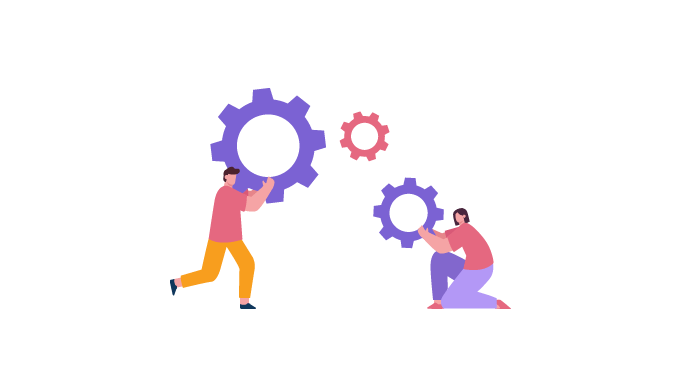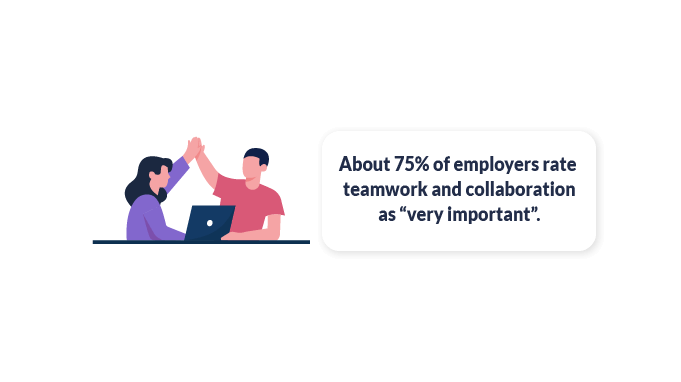What is Team Collaboration? Benefits, Types, Examples, Tips and Tools
In the bustling hub of today's workplace, there's a buzzword that's got everyone talking: team collaboration. It's like a secret sauce that makes everything taste better - smoother workflows, brighter ideas, and stronger bonds among colleagues.
But what exactly is team collaboration, and why should we care?
Well, imagine your favorite sports team scoring the winning goal or a group of musicians creating a masterpiece together. That's the magic of collaboration in action!
So, let's peel back the layers of this concept and uncover why it's the heartbeat of modern work culture.
What is Team Collaboration?

Team collaboration refers to the process by which members of a group work together to achieve a common goal or complete a shared task. It involves team building acivities that pools in their skills, knowledge, and resources to produce collective outcomes that are greater than what could be achieved by any one person working alone.
Effective team collaboration typically involves open communication, active participation, mutual respect, and a willingness to compromise and collaborate for the greater good of the team or project. Collaborative teams often leverage various tools and technologies to facilitate communication, coordination, and the sharing of information and resources.
Overall, team collaboration is essential for fostering innovation, problem-solving, and productivity in both professional and personal settings.
According to industry estimates, the team collaboration market will grow by 9.5% between now and 2030, reaching $56.67 billion.
Around 80% of users say that a platform for collaboration is essential for their work. However, 40% of businesses claim they had never used such a tool before 2020.
Benefits of Team Collaboration
1. Increased Productivity and Efficiency:
Imagine a well-oiled machine humming along smoothly - that's what happens when teams collaborate effectively! When everyone works together towards a common goal, tasks get done quicker and with fewer hiccups. It's like having a superpower that amplifies everyone's efforts, leading to greater productivity and efficiency.
2. Improved Problem-solving and Innovation:
Ever heard the saying, "Two heads are better than one"? Well, in the world of team collaboration, it's more like "Many heads are better than one!" When diverse minds come together, they bring a treasure trove of ideas and perspectives. This diversity sparks creativity and fuels innovative solutions to even the trickiest of problems.
3. Enhanced Employee Engagement and Satisfaction:
Picture this, you're part of a team where your opinions are valued, and your contributions are recognized. That's the magic of effective collaboration! When employees feel heard and appreciated, they're more engaged, motivated, and satisfied with their work. It's like being part of a supportive community where everyone has each other's backs.
4. Better Communication and Decision-making:
Clear communication is the glue that holds teams together. When team members communicate openly and honestly, it creates a smooth flow of information, ideas, and feedback. This transparency makes decision-making a breeze because everyone is on the same page. It's like having a GPS for your team - guiding you towards success with every step.
5. Stronger Team Relationships and Trust:
Trust is the foundation of every successful team, and collaboration is the mortar that strengthens it. When team members collaborate effectively, they build bonds of trust and camaraderie. They learn to rely on each other, support one another, and celebrate victories together. It's like having a second family at work - a tribe you can count on no matter what.
Types of Team Collaboration
1. Synchronous Collaboration:
Synchronous collaboration entails team members collaborating simultaneously, enabling instant interaction and feedback. This can take various forms, such as face-to-face meetings, video conferencing, phone calls, and instant messaging.
Advantages:
- Facilitates quick discussion and brainstorming.
- Enables better understanding of nonverbal cues and body language.
- Encourages active participation and engagement.
Disadvantages:
- Requires scheduling and coordinating availability, which can be challenging.
- May not be feasible for geographically dispersed teams.
- Limited by time constraints and attention spans.
2. Asynchronous Collaboration:
Asynchronous collaboration refers to team members working autonomously, often using digital tools and platforms, but at different times. This includes communication via email, utilization of project management software, sharing documents through cloud storage, and engaging in discussions on forums.
Advantages:
- Offers flexibility and accommodates different work schedules.
- Allows for considered and thoughtful responses.
- Enables asynchronous participation from geographically dispersed teams.
**Disadvantages: **
- Can lead to slower communication and decision-making.
- May hinder real-time problem-solving and brainstorming.
- Requires strong communication skills and clear instructions to avoid misunderstandings.
3. Virtual Collaboration:
Virtual collaboration brings teams together, regardless of where they are physically, using technology and digital tools. Think of video conferencing, online collaboration platforms, and cloud-based document sharing as the superheroes that make virtual collaboration possible. They allow teams to connect, brainstorm, and work on projects seamlessly, no matter the distance.
Advantages:
- Enables collaboration with geographically dispersed teams.
- Offers flexibility and work-life balance opportunities.
- Promotes diversity and inclusion by overcoming geographical barriers.
Disadvantages:
- Requires investment in technology and infrastructure.
- Can be challenging to maintain team culture and connection.
- May face technical issues and communication challenges.
4. Formal Collaboration:
Formal collaboration is characterized by a structured approach to teamwork, where roles, responsibilities, and processes are clearly defined. This method typically follows established protocols and guidelines.
Examples of formal collaboration include,
- Project teams, where individuals have assigned roles (such as project manager, developers, designers) and specific deliverables.
- Committees with predefined mandates and regular meeting schedules.
- Task forces assembled to address specific challenges, with designated leaders overseeing responsibilities and tasks.
Advantages:
- Provides clarity and structure, ensuring everyone understands their tasks and contributions.
- Streamlines workflows and decision-making processes.
- Enhances accountability and ownership within the team.
Disadvantages:
- Can be less flexible and adaptable to changing circumstances.
- May stifle creativity and spontaneous collaboration.
- Risk of becoming bureaucratic and hindering quick decision-making.
5. Informal Collaboration:
Informal collaboration refers to spontaneous and unstructured interactions between team members. It often involves spontaneous knowledge sharing, quick problem-solving, and casual communication.
Examples include:
- Brainstorming sessions where team members freely share ideas.
- Casual conversations in the break room leading to new insights.
- Quick chats or impromptu meetings to address immediate needs.
Advantages:
- Fosters creativity and innovation through spontaneous exchange of ideas.
- Builds team relationships and strengthens communication.
- Allows for quick problem-solving and adaptation to changing situations.
Disadvantages:
- Can lack structure and focus, leading to unproductive discussions.
- May not be inclusive of all team members, especially those who are introverted or less vocal.
- Difficult to track progress and ensure accountability for results.
6. Cross-functional Collaboration:
Cross-functional collaboration involves bringing together individuals from different departments or disciplines to work towards a common goal. This type of collaboration leverages diverse expertise and perspectives to achieve innovative solutions.
Examples include;
- A product development team composed of engineers, designers, marketers, and sales representatives.
- A customer service team working with technical support and product development to resolve customer issues.
- A task force was formed to address a company-wide challenge, involving representatives from various departments.
Advantages:
- Brings together diverse expertise and perspectives, leading to innovative solutions.
- Breaks down silos and fosters interdepartmental understanding.
- Improves communication and collaboration across the organization.
Disadvantages:
- Can be challenging to coordinate schedules and communication between different departments.
- May require overcoming cultural differences and conflicting priorities.
- Risk of miscommunication and misunderstandings due to differing terminology and knowledge bases.
Challenges of Team Collaboration
Navigating the waters of team collaboration often involves overcoming several obstacles that can disrupt the flow of productivity and harmony within the workplace. Here are some common challenges that teams may encounter:
1. Lack of clear communication and expectations:
Imagine a scenario where a project's requirements are communicated vaguely, leaving team members unsure of their roles and responsibilities. Without clear expectations, tasks may be duplicated, deadlines missed, or crucial details overlooked, leading to frustration and delays in project completion.
2. Different work styles and personalities:
Consider a team composed of introverts who prefer working independently and extroverts who thrive in group settings. These diverse work styles and personalities can clash, causing tension and hindering effective collaboration.
For example, introverted team members may feel overwhelmed during brainstorming sessions dominated by extroverted colleagues, leading to reduced participation and creativity.
3. Geographical dispersion and remote work:
In today's globalized world, teams often span multiple locations, with some members working remotely. While remote work offers flexibility, it can also present challenges in terms of communication and collaboration.
For instance, team members in different time zones may struggle to find overlapping working hours for meetings, leading to delays in decision-making and project progress. This gave rise to the focus of remote team collaboration through tools like Microsft Teams, Skype, online scrum tools etc.
4. Inadequate collaboration tools and technologies:
Picture a team attempting to collaborate using outdated or incompatible software, resulting in inefficiencies and frustration. Without access to modern collaboration tools like project management software or cloud-based document sharing platforms, team members may resort to using email for communication and file sharing, leading to version control issues and information silos.
That is why most companies opt for collaboration tools for both onsite and remote team to ease the distribution of information within the workplace. Vantage Circle's collaboration with MS teams enables seamless digital rewards and recognition for corporate clients.
5. Unhealthy team dynamics and conflicts:
Consider a team where unresolved conflicts simmer beneath the surface, creating a toxic work environment. For example, disagreements over project priorities or conflicting personalities can escalate into heated arguments, undermining trust and collaboration.
Addressing such conflicts promptly and constructively is essential to fostering a positive team culture and maintaining productivity.
By acknowledging and addressing these challenges head-on, teams can cultivate a culture of open communication, mutual respect, and collaboration, ultimately leading to greater success and satisfaction in the workplace.
How to Build a Collaborative Team Culture
1. Set Clear Goals and Expectations
- Define team goals and individual roles to provide clarity and direction.
- Establish clear communication channels and protocols to ensure everyone is on the same page.
- Set deadlines and expectations for deliverables to maintain accountability and progress.
2. Foster Open Communication and Trust
- Encourage active listening and respectful dialogue to facilitate meaningful exchanges.
- Promote transparency and information sharing to build trust and foster a collaborative environment.
- Build trust through reliable information and follow-through on commitments to strengthen team cohesion.
3. Celebrate Diversity and Encourage Inclusion
- Value different perspectives and work styles to leverage the full potential of diverse talents.
- Create a safe space for open communication and feedback to promote inclusivity and belonging.
- Utilize diverse teams to leverage multiple strengths and drive innovation and creativity.
4. Invest in Collaboration Tools and Technologies
- Identify tools that meet your team's specific needs, such as project management and communication platforms.
- Ensure tools are user-friendly and accessible to all team members to facilitate seamless collaboration.
- Provide training and support on using collaboration tools effectively to maximize their benefits and streamline workflows.
Importance of Fostering Team Collaboration

Collaboration in the workplace is directly related to employee autonomy and healthy company culture. Although nowadays, it’s used more out of convenience and has become more of a buzzword, it is not a meaningless cliche.
- Believe it or not, collaboration makes teams click and companies successful.
- It encourages employees to have a say in the decision-making process.
- It creates an environment of trust where employees feel their ideas are valued and taken seriously.
- It brings everyone to work towards the same common goal as a team while improving the organization's overall corporate culture.
However, the problem occurs when people are stuck behind desks and start detaching from the company mission and the team.
This is where employees speak different languages, and the work gets done in silos resulting in confusion, chaos, and expensive delays.
A collaborative culture has become an essential part of modern business. The traditional "lonely" working environment is on its way out, and collaboration is what propels corporations forward.
Best Practices for Successful Team Collaboration
1. Effective Communication Strategies
Effective communication lies at the heart of successful team collaboration. Here are some key strategies to enhance communication within your team:
Utilize the right communication channels for different purposes: Tailor your communication approach based on the nature of the message and the intended audience, choosing between email, instant messaging, video calls, or face-to-face interactions as appropriate.
- Practice active listening and provide constructive feedback: Actively listen to your team members' input and concerns, ensuring everyone feels heard and valued. Offer constructive feedback to encourage continuous improvement and growth.
- Encourage regular team meetings and check-ins: Schedule regular team meetings to discuss progress, share updates, and address any challenges or roadblocks. Additionally, conduct periodic check-ins to ensure everyone is on track and aligned with the team's objectives.
2. Establish Clear Roles and Responsibilities
Clear delineation of roles and responsibilities is essential for effective team collaboration. Here's how to ensure clarity and accountability within your team:
- Define individual roles and responsibilities within the team: Clearly outline each team member's specific role and the tasks they are responsible for, ensuring everyone understands their contribution to the team's objectives.
- Ensure there is no overlap or duplication of work: Avoid confusion and inefficiency by clarifying boundaries and ensuring tasks are assigned based on each team member's expertise and strengths.
- Empower team members to take ownership of their tasks: Encourage autonomy and initiative by empowering team members to take ownership of their assigned tasks, fostering a sense of accountability and motivation to deliver results.
3. Foster a Culture of Recognition and Appreciation
In cultivating a collaborative team environment, it's crucial to nurture a culture of recognition and appreciation. Here's how:
- Celebrate individual and team accomplishments: Acknowledge and celebrate the achievements of individuals and the team. This fosters a sense of pride and motivation, encouraging continued excellence.
- Recognize and reward collaborative efforts: Highlight instances of effective collaboration and teamwork, recognizing the contributions of team members who go above and beyond to support each other and achieve shared goals.
- Provide opportunities for professional development and growth: Invest in the growth and development of your team members by offering training, mentorship, and opportunities for advancement. This demonstrates your commitment to their success and reinforces a culture of continuous learning and improvement.
How to Choose the Right Collaboration Tools for Your Team !
Selecting the appropriate collaboration tools is crucial for fostering effective teamwork and productivity within your team.
Here are some tips on how to choose the best collaboration for your company:
1. Identify Your Team's Needs and Challenges
Before diving into selecting collaboration tools, it's essential to assess your team's requirements and understand the challenges they face. Here's how:
-
Analyze your team's size, work style, and collaboration requirements: Consider the size of your team and how they prefer to work together. Evaluate the nature of your team's projects and tasks, as well as the frequency and methods of collaboration required.
-
Consider specific challenges faced by your team: Reflect on any obstacles or pain points hindering collaboration within your team. This could include issues with communication, project management, file sharing, or remote work. Understanding these challenges will help you prioritize features and functionalities when evaluating collaboration tools.
2. Evaluate Different Collaboration Tools
Once you've identified your team's needs and challenges, it's time to explore and compare various collaboration tools to find the best fit. Here's how to proceed:
- Research and compare popular collaboration tools based on features, pricing, and ease of use: Start by researching different collaboration tools available in the market. Look for features that align with your team's requirements, such as task management, file sharing, communication channels, and integration capabilities.
Consider factors like pricing plans and scalability to ensure the tool fits your budget and can accommodate your team's growth. Additionally, prioritize tools that are user-friendly and intuitive, as ease of use is essential for adoption and efficiency.
-
Read reviews and testimonials from other users: Gain insights from real users by reading reviews and testimonials about the collaboration tools you're considering. Pay attention to both positive and negative feedback to understand the strengths and weaknesses of each tool. Look for reviews from teams with similar needs and challenges to gauge how well the tool may address your requirements.
-
Leveraging Peer Insights for Informed Collaboration Tool Selection: Additionally, consider reaching out to colleagues or industry peers for recommendations and firsthand experiences with collaboration tools they've used. This research phase will help you make an informed decision and select the collaboration tool that best suits your team's needs.
3. Implement and Integrate Tools Effectively
After selecting the right collaboration tools, it's crucial to ensure their successful implementation and integration into your team's workflow. Here's how to do it:
-
Provide training and support for team members on using new tools: Offer comprehensive training sessions or tutorials to familiarize team members with the features and functionalities of the selected collaboration tools. Also, provide ongoing support and resources to address any questions or concerns during the transition period.
-
Integrate collaboration tools with existing workflows seamlessly: Ensure smooth integration of the new tools into your team's existing processes and workflows. Identify opportunities to streamline tasks and enhance productivity by leveraging the capabilities of the collaboration tools. This may involve customizing settings, creating automated workflows, or integrating with other essential tools and systems used by your team.
-
Monitor and assess the effectiveness of chosen tools: Continuously evaluate the performance and impact of the collaboration tools on your team's productivity and collaboration efforts. Gather feedback from team members regarding their experiences with the tools and identify areas for improvement or optimization. Regularly review key metrics and analytics to gauge the effectiveness of the tools in meeting your team's objectives. Adjust strategies and workflows as needed to maximize the benefits of the chosen collaboration tools.
Bottomline
In today's fast-paced business landscape, fostering effective team collaboration is not just a choice but a necessity for success. By understanding the importance of collaboration, selecting the right tools, implementing best practices, and addressing common challenges, businesses can unlock the full potential of their teams and drive innovation, productivity, and growth.
Frequently Asked Questions
1. Why is good team collaboration important in modern business?
Effective team collaboration fosters innovation, productivity, and adaptability, driving business success in today's dynamic environment. It enables diverse talents to come together, leveraging individual strengths to achieve common goals efficiently.
2. Why is teamwork important in collaboration?
Teamwork is the foundation of collaboration, emphasizing collective effort, shared accountability, and mutual support. It encourages synergy among team members, leading to enhanced creativity, problem-solving, and overall performance.
3. Difference between team collaboration vs. teamwork
While teamwork emphasizes joint effort towards a common goal, team collaboration extends beyond mere cooperation to involve active communication, idea sharing, and coordinated action. Collaboration emphasizes leveraging diverse perspectives and skills to achieve shared objectives effectively.
4. How can team collaboration be measured?
Team collaboration can be assessed through various metrics such as project completion rates, meeting effectiveness, communication responsiveness, and employee satisfaction surveys. Additionally, qualitative feedback and observations can provide insights into team dynamics and collaboration effectiveness.
5. What are some tools that can be adopted to enhance team collaboration?
Some tools that can be adopted to enhance team collaboration include project management software, collaboration tools, communication platforms, and team calendars.

















